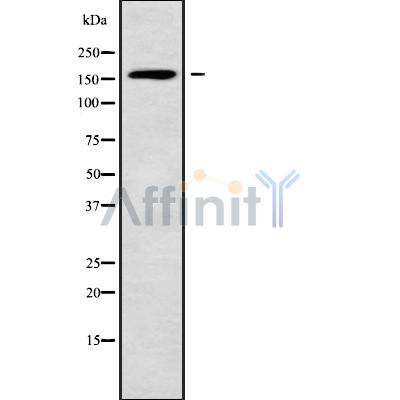ABCC11 Antibody - #DF9253
| Product: | ABCC11 Antibody |
| Catalog: | DF9253 |
| Description: | Rabbit polyclonal antibody to ABCC11 |
| Application: | WB IHC IF/ICC |
| Reactivity: | Human |
| Prediction: | Bovine, Horse, Dog |
| Mol.Wt.: | 154kDa; 154kD(Calculated). |
| Uniprot: | Q96J66 |
| RRID: | AB_2842449 |
Related Downloads
Protocols
Product Info
*The optimal dilutions should be determined by the end user. For optimal experimental results, antibody reuse is not recommended.
*Tips:
WB: For western blot detection of denatured protein samples. IHC: For immunohistochemical detection of paraffin sections (IHC-p) or frozen sections (IHC-f) of tissue samples. IF/ICC: For immunofluorescence detection of cell samples. ELISA(peptide): For ELISA detection of antigenic peptide.
Cite Format: Affinity Biosciences Cat# DF9253, RRID:AB_2842449.
Fold/Unfold
ABCC 11; ATP binding cassette protein C11; ATP binding cassette sub family C (CFTR/MRP) member 11; ATP binding cassette sub family C member 11; ATP binding cassette transporter MRP8; ATP binding cassette transporter sub family C member 11; EWWD; MRP8; Multi resistance protein 8; Multidrug resistance associated protein 8; OTTHUMP00000164191; WW;
Immunogens
A synthesized peptide derived from human ABCC11, corresponding to a region within the internal amino acids.
Expressed in ceruminous apocrine gland (at protein level) (PubMed:19383836, PubMed:19710689). Expressed in many tissues. Not expressed in kidney, spleen and colon. Highly expressed in breast cancer. Expressed at moderate levels in normal breast and testis and at very low levels in liver, brain and placenta.
- Q96J66 ABCCB_HUMAN:
- Protein BLAST With
- NCBI/
- ExPASy/
- Uniprot
MTRKRTYWVPNSSGGLVNRGIDIGDDMVSGLIYKTYTLQDGPWSQQERNPEAPGRAAVPPWGKYDAALRTMIPFRPKPRFPAPQPLDNAGLFSYLTVSWLTPLMIQSLRSRLDENTIPPLSVHDASDKNVQRLHRLWEEEVSRRGIEKASVLLVMLRFQRTRLIFDALLGICFCIASVLGPILIIPKILEYSEEQLGNVVHGVGLCFALFLSECVKSLSFSSSWIINQRTAIRFRAAVSSFAFEKLIQFKSVIHITSGEAISFFTGDVNYLFEGVCYGPLVLITCASLVICSISSYFIIGYTAFIAILCYLLVFPLAVFMTRMAVKAQHHTSEVSDQRIRVTSEVLTCIKLIKMYTWEKPFAKIIEDLRRKERKLLEKCGLVQSLTSITLFIIPTVATAVWVLIHTSLKLKLTASMAFSMLASLNLLRLSVFFVPIAVKGLTNSKSAVMRFKKFFLQESPVFYVQTLQDPSKALVFEEATLSWQQTCPGIVNGALELERNGHASEGMTRPRDALGPEEEGNSLGPELHKINLVVSKGMMLGVCGNTGSGKSSLLSAILEEMHLLEGSVGVQGSLAYVPQQAWIVSGNIRENILMGGAYDKARYLQVLHCCSLNRDLELLPFGDMTEIGERGLNLSGGQKQRISLARAVYSDRQIYLLDDPLSAVDAHVGKHIFEECIKKTLRGKTVVLVTHQLQYLEFCGQIILLENGKICENGTHSELMQKKGKYAQLIQKMHKEATSDMLQDTAKIAEKPKVESQALATSLEESLNGNAVPEHQLTQEEEMEEGSLSWRVYHHYIQAAGGYMVSCIIFFFVVLIVFLTIFSFWWLSYWLEQGSGTNSSRESNGTMADLGNIADNPQLSFYQLVYGLNALLLICVGVCSSGIFTKVTRKASTALHNKLFNKVFRCPMSFFDTIPIGRLLNCFAGDLEQLDQLLPIFSEQFLVLSLMVIAVLLIVSVLSPYILLMGAIIMVICFIYYMMFKKAIGVFKRLENYSRSPLFSHILNSLQGLSSIHVYGKTEDFISQFKRLTDAQNNYLLLFLSSTRWMALRLEIMTNLVTLAVALFVAFGISSTPYSFKVMAVNIVLQLASSFQATARIGLETEAQFTAVERILQYMKMCVSEAPLHMEGTSCPQGWPQHGEIIFQDYHMKYRDNTPTVLHGINLTIRGHEVVGIVGRTGSGKSSLGMALFRLVEPMAGRILIDGVDICSIGLEDLRSKLSVIPQDPVLLSGTIRFNLDPFDRHTDQQIWDALERTFLTKAISKFPKKLHTDVVENGGNFSVGERQLLCIARAVLRNSKIILIDEATASIDMETDTLIQRTIREAFQGCTVLVIAHRVTTVLNCDHILVMGNGKVVEFDRPEVLRKKPGSLFAALMATATSSLR
Predictions
Score>80(red) has high confidence and is suggested to be used for WB detection. *The prediction model is mainly based on the alignment of immunogen sequences, the results are for reference only, not as the basis of quality assurance.
High(score>80) Medium(80>score>50) Low(score<50) No confidence
Research Backgrounds
Participates in physiological processes involving bile acids, conjugated steroids and cyclic nucleotides. Enhances the cellular extrusion of cAMP and cGMP. Stimulates the ATP-dependent uptake of a range of physiological and synthetic lipophilic anions, including the glutathione S-conjugates leukotriene C4 and dinitrophenyl S-glutathione, steroid sulfates such as dehydroepiandrosterone 3-sulfate (DHEAS) and estrone 3-sulfate, glucuronides such as estradiol 17-beta-D-glucuronide (E(2)17betaG), the monoanionic bile acids glycocholate and taurocholate, and methotrexate. Probably functions to secrete earwax. Required for the secretion of components contributing to axillary odor formation.
Cell membrane>Multi-pass membrane protein. Vacuole membrane. Cytoplasmic vesicle membrane.
Expressed in ceruminous apocrine gland (at protein level). Expressed in many tissues. Not expressed in kidney, spleen and colon. Highly expressed in breast cancer. Expressed at moderate levels in normal breast and testis and at very low levels in liver, brain and placenta.
Belongs to the ABC transporter superfamily. ABCC family. Conjugate transporter (TC 3.A.1.208) subfamily.
Research Fields
· Environmental Information Processing > Membrane transport > ABC transporters.
Restrictive clause
Affinity Biosciences tests all products strictly. Citations are provided as a resource for additional applications that have not been validated by Affinity Biosciences. Please choose the appropriate format for each application and consult Materials and Methods sections for additional details about the use of any product in these publications.
For Research Use Only.
Not for use in diagnostic or therapeutic procedures. Not for resale. Not for distribution without written consent. Affinity Biosciences will not be held responsible for patent infringement or other violations that may occur with the use of our products. Affinity Biosciences, Affinity Biosciences Logo and all other trademarks are the property of Affinity Biosciences LTD.


